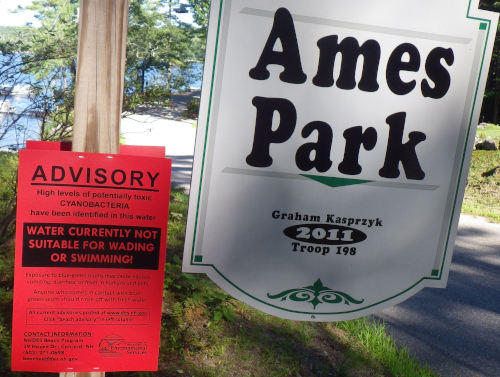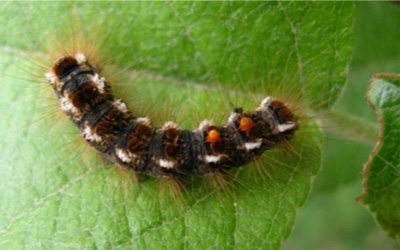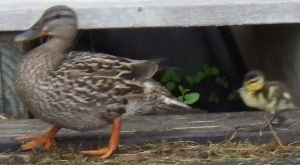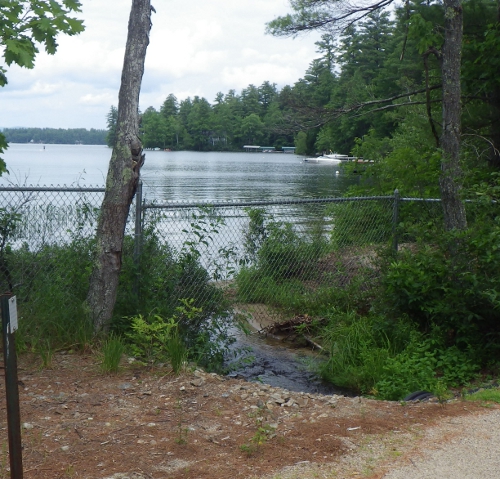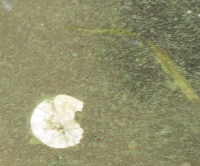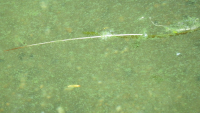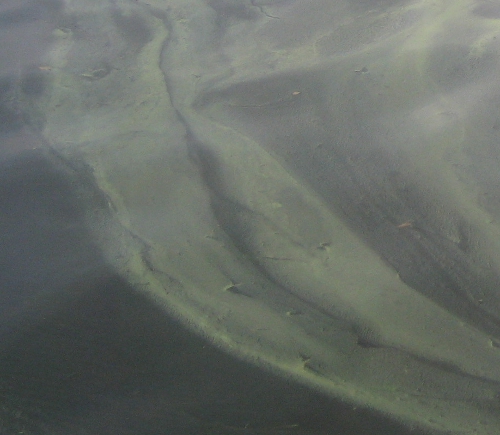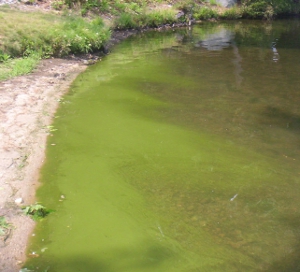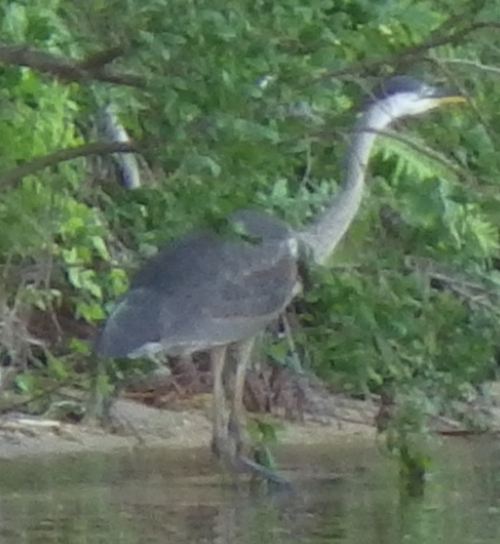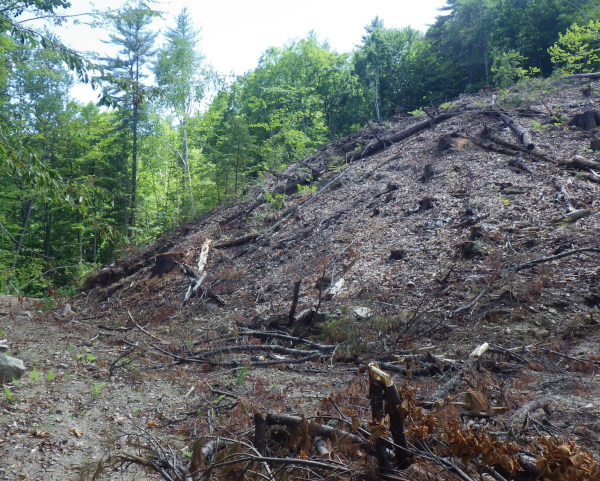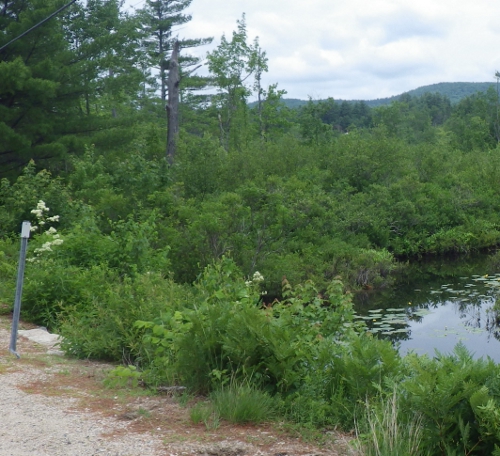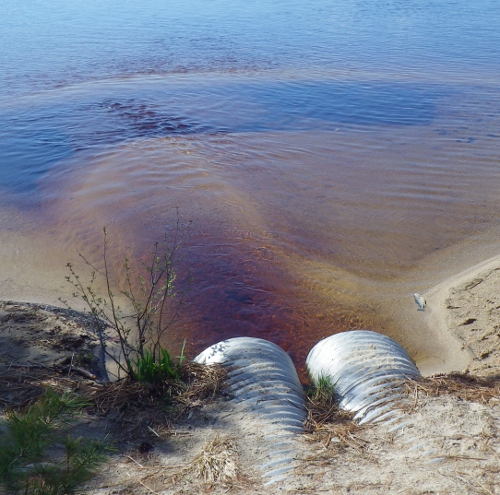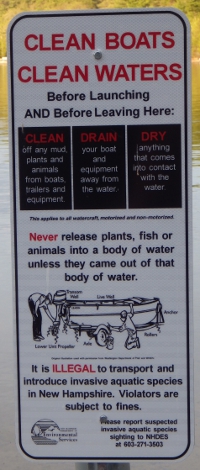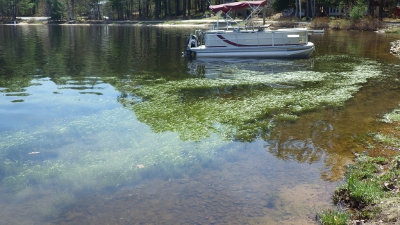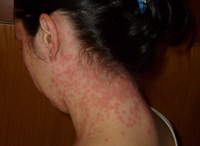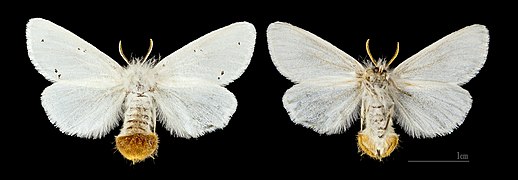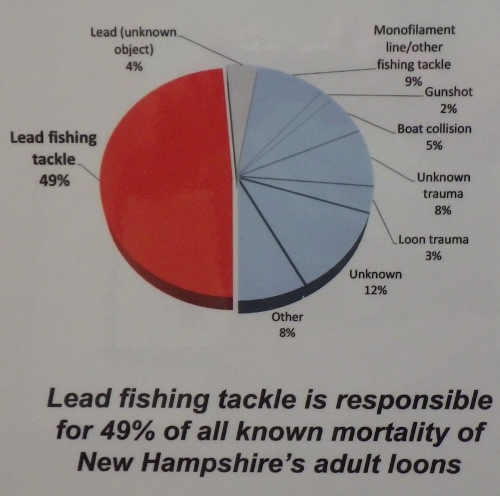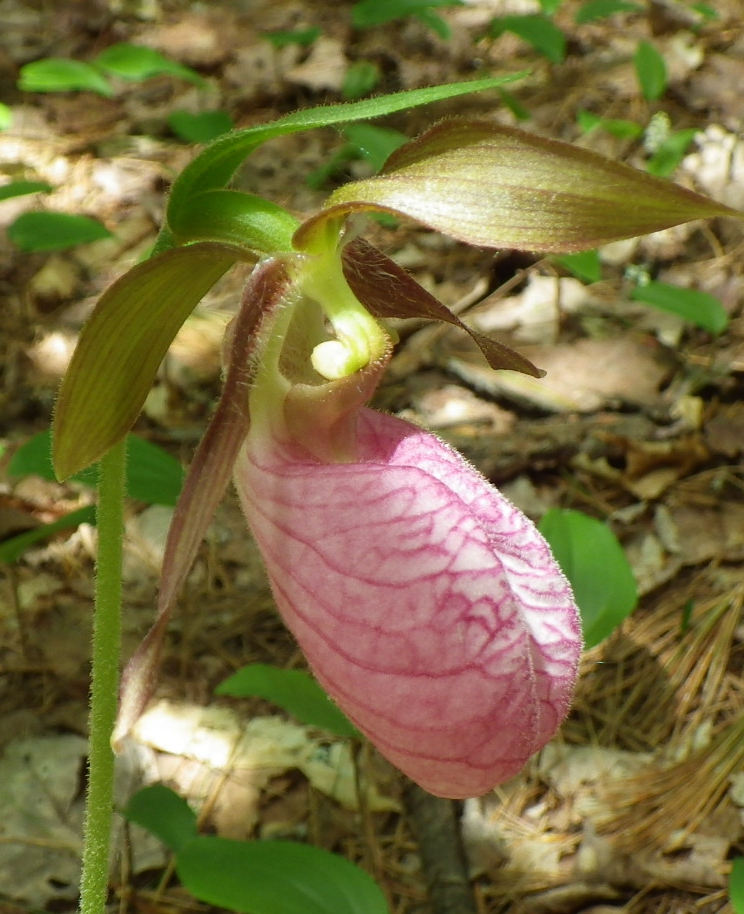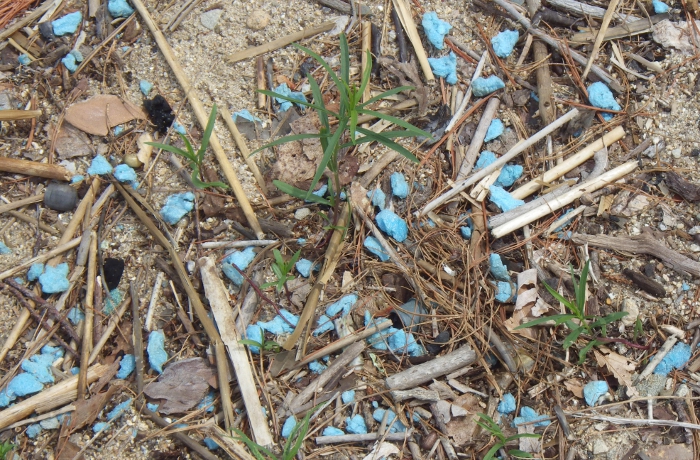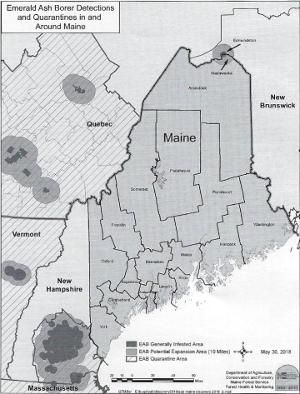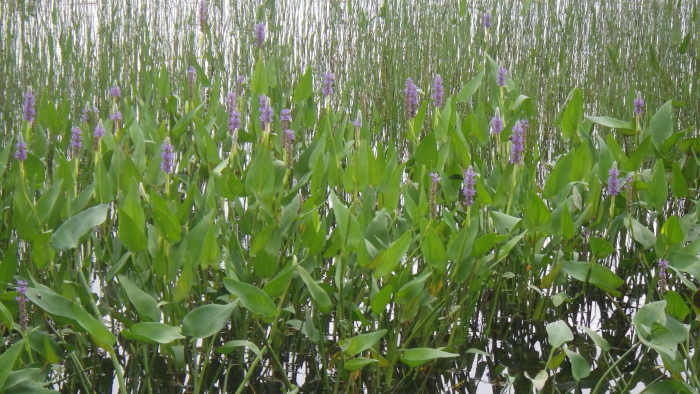Water Quality Monitoring of Province Lake
Effingham & Wakefield, New Hampshire, and Parsonsfield, Maine
2018 Report - Published Online on July 17, 2019
2018 was the 28th consecutive year of water quality monitoring conducted at Province Lake. The first 23 years of monitoring were conducted as part of the New Hampshire Volunteer Lake Assessment Program (VLAP). In 2014, the Province Lake Association (PLA) switched to the University of New Hampshire (UNH) Lakes Lay Monitoring Program (LLMP). While making this change had multiple benefits, the downside is that the 23-year continuous record of consistent analyses by VLAP has been broken, so data are not always comparable. See the 2015 report for details of the impact.
The deep spot was sampled 5 times (June through October) in 2018, the same number of times as in 2016 and 2017. The standard inlets and lake outlet were sampled 7 times (April through October). Several other places were sampled 1 or 2 times. Seven (7) lake locations were sampled only for phosphorus 4 times in a 10-day span in late August and early September, presumably for a particular study.
I obtained the 2018 data for analysis directly from Bob Craycraft of UNH Cooperative Extension. Since they end up sending the data to NH Department of Environmental Services (DES) for their Environmental Monitoring Database (EMD), all data are therefore public information. In order to compare 2018 UNH results to prior years, only the June through September data (summer season) were used in this report; this is consistent with all prior reports.
Many of the terms in this report include hyperlinks to related web sites. By clicking on most of the underlined terms, you can access additional information. Clicking on most photos will get you a large photo with wider angle and higher resolution. To get back to the report from a photo, click the back arrow on your browser or [ALT]+[←] on your keyboard.
Use this menu to jump to a particular topic:
Overall Summary
- Water transparency was good at 2.83 meters, nearly the same as the prior year (2017).
- Province Lake had a Lake Warning issued by DES for a cyanobacteria bloom August 6-16 last year.
This was subsequent to having a bloom in late November, 2017, and no reportable cyanobacteria blooms in 2014 through
2016, after having had them 4 years in a row (2010-2013).
WARNING: Since Province Lake has a history of cyanobacteria blooms of varying severity, it is advisable to have a look at the water each time you or your children plan to swim. We've been mostly lucky lately, but caution is always advisable. Since a cyanobacteria bloom is readily visible, if you don't see it, swimming is safe.
Two excellent sources of information about cyanobacteria are this DES web site and this DES Fact Sheet. The DES web site is far more detailed. - Average phosphorus concentrations in the upper and lower layers of the lake increased somewhat above the prior 2 years (2016-17). Chlorophyll-a fell to the lowest concentration since 2013. A discussion of the relationship between phosphorus and chlorophyll-a is included in the details below.
- The surface layers of the lake were close to neutral acidity, with pH's very close to 7.0, virtually the same as in 2016. This is good.
-
When the latest (2018) lake report card
was compared to the previous (2016) report card,there was one change reflected in 3 places.
The 2018 report card shows that the last E. coli sampling within the lake was performed in 2009. While the 2016 report card shows that those
results were sufficient to give us a "2-G" rating (the best) for the E. coli parameter, those same results now give us a downgrade to a "3-PAS"
rating (insufficient data/potentially [OK]), probably because the data are considered to be too old. As noted in the details below, plenty of E. coli
analyses were performed in 2013 for the Watershed Management Plan. However, apparently none were performed in the Deep Spot, so they were not considered valid to
renew the lake's "2-G" rating. Because of this E. coli downgrade, the boating use rating also was downgraded to "3-PAS". Due to the circumstances
of the downgrade and the lack of concern raised by the 2013 E. coli sampling program, my opinion is that the downgrade may look bad on paper, but
is probably of no actual concern to users of the lake. The complete report card for the South River watershed, which includes Province Lake, is HERE.
Province Lake remains rated "5-M", "Marginally Impaired" for swimming, because of the history of cyanobacteria blooms, but now also for E. coli. Read what "impaired" means. Since 2010, Province Lake has been listed as "Marginally Impaired" in the "Aquatic life" use category for chlorophyll-a and total phosphorus. By 2008, the lake had already been so listed for pH and mercury in fish. On the 2018 list for "Potential Drinking Water Supply", Province Lake still received the "2-G" rating (the best rating).
My recommendation to the UNH sampling program is that they do an E. coli sampling and analysis at the Deep Spot during 2019, simply to provide the DES the data they will need to restore in 2020 the "2-G" ratings Province Lake lost in 2018, due to old data. - Coastal Maine has a serious infestation of the invasive Browntail Moth this year. This is not just the typical problem of being bad for trees, but an actual human health issue of shed hairs causing respiratory distress or poison-ivy type rashes. It has the potential to appear near Province Lake. See the details below.
Details
This section provides a more detailed look at the UNH LLMP water quality data for Province Lake for June through September 2018. Data from the excluded months is outside of the peak growing season, so is not typical.
1. Water transparency (a measure of how deep you can see into the water) was an average of 2.83 meters (9.3 feet) in the deepest part of the lake, a decrease of only 2 inches from the prior year (2017). The 2018 average transparency is clustered within the 7 years of good transparencies we have had since 2012 that followed many years of mostly slowly degrading transparencies. Please note that I am reporting the transparency that is measured without a viewscope because it represents how most people actually observe the lake. The viewscope method represents how you would see the lake through a diving mask or swim goggles. For comparison, the average 2018 viewscope transparency was 3.30 meters (10.9 feet), a decrease of an inch from 2017. The statewide median transparency is 3.2 meters (10.5 feet), without a viewscope. We have a shallow lake, so sediments are easily stirred up, therefore we expect to be below the state average. The deepest part of the lake is only 16 to 17 feet deep, as shown on the NH bathymetric chart.
2. Chlorophyll-a concentrations are used to indicate the average amount of algae (2) in the lake. The 2018 chlorophyll-a concentrations fell significantly to an average of 2.89 micrograms per liter (ug/L), a concentration that is < 80% of the 2017 average and the 8th highest in 28 years, only about 77% of the 28-year mean average.
This places our 2018 average concentration at only 63% of the average amount that New Hampshire lakes had. Happily, Province Lake has been below the current NH median chlorophyll-a of 4.58 ug/L since 2005 and has only exceeded it 4 times in 28 years. A low level is good because dying algae forms the brown floating bottom masses in July and August. The algae masses settle loosely on the bottom when the lake is still and cloud the water when wind or boat wakes stir things up. This may be unsightly, but it is not harmful to anyone or their animals.3. Phosphorus is a nutrient required for photosynthesizing organism growth and is typically thought to be the nutrient whose availability most limits plant, algae, and cyanobacteria growth in NH lakes. In 2018, the average phosphorus levels in the upper water layer (sampled at 2.0 meters depth) were almost 10% above the 28-year mean average, a 14% increase over the prior year (2017). The 2018 level exceeds that in 50% of the lakes in NH, as it usually has.
The total phosphorus concentrations over the years have been high enough to earn Province Lake a "Marginal Impairment" listing in the "Aquatic life" use category, ever since NH DES started issuing listings of impairments for phosphorus and chlorophyll-a in 2010, as explained in 2013's Issue #5 of the Province Lake Water Newsletter.
In the lower water layer (sampled at 4.0 meters depth), the average phosphorus levels were <3% higher than those at 2.0 meters, and 12% higher than the previous year. They rank 13th highest of the 18 years of data since those measurements started in the year 2000 (2003 was skipped.).
The phosphorus concentration at the Rt. 153 Inlet (in NH, near the state line) continues to be elevated, with its 2018 level about 4% higher than the previous year. That made this the 12th lowest in 28 years, so is still a good value. The average phosphorus concentrations measured at the Island Inlet on Bonnyman Road were virtually identical to those in 2017, making it the 5th lowest in 28 years, so not of great concern. Phosphorus clings to sediments, so soil erosion and sediment disturbance can increase phosphorus concentrations. Both inlet locations have a history of elevated and fluctuating total phosphorus concentration. The lake view at the Island Inlet is shown here. Click the photo to see where the sample is taken.
It is important to educate lake users on the importance of operating jet skis and boats at slow speeds in shallow areas to minimize disturbance to sediments and vegetation. Churning up the bottom sediments releases phosphorus, which promotes plant, algae, and cyanobacteria growth; increases turbidity (scattering of light by suspended particles), and decreases clarity.
4. Chlorophyll-a versus Phosphorus: A common question I and others have is "What causes increases in chlorophyll-a concentrations?" The common rote answer is "Increases in phosphorus concentrations". But is it really?
I asked a research statistician for help and we found the following:
- Using the full 28 years of data, variations in the phosphorus concentrations in the upper layers accounted for about 10% of the variations in chlorophyll-a.
- Using the full 18 years of data from the lower layers (3.5 m to bottom), <2% of the phosphorus concentration variations accounted for chlorophyll-a variations. This is essentially nothing, which makes sense, since the phytoplankton will concentrate near the water surface, where there is more light.
- I also ran the analyses excluding the most recent 5 years of data, when the sampling and lab analyses were done by the UNH program, rather than VLAP, in case the resulting data were somehow not fully compatible. The upper layer phosphorus then accounted for about 16% of the chlorophyll-a variation and the lower layer phosphorus accounted for about 5% of the chlorophyll-a variation.
Conclusions:
- Phosphorus concentration is a factor in chlorophyll-a production, but does not control it. Other variables account for 84% to 90% of the changes in chlorophyll-a. Weather is likely the most important factor, but quantifying that influence is difficult. Nitrogen concentration may also be a factor, but at least 10 years of data are required for a meaningful statistical analysis. Fortunately, UNH is now collecting nitrogen data, so an analysis can be run 5 years from now. Stay tuned!
- Some systemic difference between the UNH and VLAP protocols make their results not fully compatible.
5. We had never sampled Province Lake for nitrogen as part of VLAP, but it is now included in the new UNH Lakes Lay Monitoring Program. A 1987 DES Lake Assessment Program survey had concluded that plant and algae growth in Province Lake is actually limited by the amount of nitrogen, rather than by phosphorus. Now that nitrogen is being monitored, we have the potential to eventually learn if that is true. At least 10 years of data are required before a meaningful statistical analysis can be performed. Meanwhile, it is important to be sure nitrogen-containing fertilizers are not used near the shoreline, or streams or ditches feeding the lake, and to be sure septic systems are operating properly. It would also be a tiny help not to pee in the lake while swimming; each time adds about 40 milligrams of nitrogen to the water.
If you have a lush, bright green lawn, it could be a sign to your neighbors and the community that you are fertilizing your lawn, possibly making a significant contribution of nitrogen and/or phosphorus to the lake. On the other hand, if you pump water directly out of the lake to irrigate your lawn, you can contribute to improving the lake water quality by removing nutrients from the water and putting them to use on your lawn; I have been told that some people actually do this here.
6. Province Lake had a Lake Warning issued by DES for a cyanobacteria bloom August 6-16 last year (shown here). This was subsequent to having a bloom in late November, 2017, and no reportable cyanobacteria blooms in 2014 through 2016, after having had them 4 years in a row (2010-2013).
Excerpts from the DES 8/16/2018 press release provide useful information:
- On 8/16/2018 DES "removed a cyanobacteria lake warning issued on 8/6/2018. The advisory was issued based on visual evidence of accumulations of cyanobacteria throughout the lake. The bloom quickly dissipated and was reported to be clear the following few days. Samples were collected 8/15/2018 and contained few decaying colonies of Anabaena/Dolichospermum.
- "Cyanobacteria are natural components of water bodies worldwide, but blooms and surface scums may form when excess nutrients are available to the water. Some cyanobacteria produce toxins that are stored within the cells that can be released upon cell death. Toxins can cause both acute and chronic health effects that range in severity. Acute health effects include irritation of skin and mucous membranes, tingling, numbness, nausea, vomiting, seizures and diarrhea. Chronic effects include liver and central nervous system damage.
- "NHDES advises lake users to avoid contact with the water in areas experiencing elevated cyanobacteria cell conditions typically where lake water has a surface scum, green streaks or blue-green flecks aggregating along the shore. NHDES also advises pet owners to keep their pets out of any waters that have a cyanobacteria bloom.
- "NHDES routinely monitors public beaches and public waters of the state for cyanobacteria. Once a cyanobacteria lake warning or beach advisory has been issued, NHDES returns to affected waterbodies on a weekly basis until the cyanobacteria standards are again met."
Province Lake had experienced its first confirmed cyanobacteria bloom since the 1970's in September 2010, then had blooms 4 years in a row (2010-2013). Fortunately, no sightings worthy of a Lake Warning then occurred during 2014 through 2016. The blooms this decade mean we are susceptible to having them in future years. When a cyanobacteria bloom is in progress (see description below), there is no way for us to know if it is toxic or not, so we need to act as if it is toxic. Therefore, it is important to know what a bloom looks like and act accordingly. If a cyanobacteria bloom is suspected, there may be Facebook postings and/or email alerts issued.
What a Cyanobacteria Bloom Looks Like: Large concentrations of cyanobacteria (a bloom) would be seen as a green, blue, or pink surface scum in a section of the lake. This is different from the tan or yellowish foam seen sometimes after strong winds. If present in large amounts, cyanobacteria can be toxic to animals and humans. While recreational exposure to cyanobacteria toxins is a major concern of NH DES, there have been no documented cases of cyanotoxin-related illnesses in New Hampshire. Photo by NH DES, courtesy of the PLA, 2012.
If you think you are seeing a cyanobacteria bloom, stay out of the water and especially, keep your children and pets out of the water. Call the NH DES Cyanobacteria Hotline at (603) 848-8094 or email beaches@des.nh.gov to describe what you see. Then call the PLA's phone number, (207) 200-3243, so a sample can be promptly collected for potential NH DES analysis. See Item 2 of the Overall Summary above for links to more info. If suspicious, during "swim season" NH DES may sample and analyze the suspected bloom, then post a Lake Warning if there is any danger. They will monitor the situation and remove the postings when all is clear.
According to the DES web site, research indicates that cyanobacteria numbers increase as nutrients in the water increase. Therefore, the best ways to try to minimize cyanobacteria blooms are to eliminate fertilizer use on lawns, to keep the lake shore natural, to protect against shoreline erosion, and to properly maintain septic systems. These measures will only become more important as the pressure of human population growth results in more land being cleared and developed in the Province Lake watershed. The specific causes of our own blooms is unknown, but preventing future blooms is a major goal of the Watershed Management Plan.
7. A pH between 6.5 to 7.0 is ideal for fish, according to VLAP. pH is the measure of acidity, where 7.00 is neutral, below 7 is acidic, and above 7 is basic. Starting in 2015, UNH measured pH two different ways, using a YSI Professional Plus multi-parameter meter (probe) to measure pH in the field immediately upon sampling, and a laboratory analysis of the bottled sample. In 2018, the probe readings indicated an average pH of 6.96 in the upper layers and 6.82 in the lower layers. Lab measurements averaged 7.17 in the upper layers and 7.05 in the lower layers. The state average in the upper layers is 6.6. The lake in 2018 was close to being the least acidic it has been in 28 years.
The average lab-measured pH at the Rt. 153 inlet (shown here) was 6.21, a bit more acidic than last year's pH of 6.45, which qualified as the highest average pH in 28 years. The only years less acidic than 2018 were the 3 years that immediately preceded it (2015-17), based on the lab analysis results. This inlet drains a large wetland, which naturally has a high concentration of tannic, humic, and fulvic acids from decomposition of plant life, which give it the color of tea and reduce its pH. No problem is indicated. The average lab-measured pH at the Island Inlet was 6.50, slightly more acidic than the prior year and the 8rd least acidic in 28 years. Less acidic inflowing waters are good for the lake. This inlet also drains a wetland. The higher pH's at both inlets are not explained by the available data, however, they are consistent with the higher pH in the lake.Exceedances of the Water Quality Criteria for pH are defined as: pH < 6.5 or pH > 8.0. The state average pH of 6.6 is barely better than the 6.5 criterion, therefore a large number of New Hampshire water bodies are listed as "Slight impairment - marginal condition" in the "Aquatic life" use category for pH. Although our current pH is excellent, questions 4 and 4A of the 2012 supplemental report explain why Province Lake is listed as "Slight impairment - marginal condition" for pH and will probably stay listed for years. Despite the regulatory inertia that keeps this pH impairment listed, the fact that our surface layers were not acidic, but straddled neutrality (7.00) in 2018 indicate that this is one water quality parameter that we need not worry about at this time.
8. Province Lake was listed in 2008 as impaired for mercury in fish and it remains so with all other surface waters in New Hampshire (3). Two fish from Province Lake tested in 2009 were shown to have safe mercury levels, but just two fish cannot be assumed to be sufficiently representative of all fish in the lake, especially since 10 years have passed since those fish were caught. It's better to be cautious and do catch-and-release, which makes for better fishing anyway, not to mention leaving food for the loons and bald eagles.
| Depth (meters) | DO (% saturation) |
|---|---|
| 0.1 | 90% |
| 0.5 | 90% |
| 1.0 | 89% |
| 1.5 | 89% |
| 2.0 | 89% |
| 2.5 | 89% |
| 3.0 | 88% |
| 3.5 | 80% |
| 4.0 | 74% |
| 4.5 | 62% |
9. Thanks to the UNH program, dissolved oxygen (DO) was measured 4 times last summer season and once in October, rather than once every 2 years under the VLAP schedule. In 2018, averaging across all depths for all 4 months, the DO was at 89% saturation in the deep part of the lake. The table at right provides the average saturation at each depth for the 4 measurements. This detail of DO data was never available under VLAP, so there is insufficient past data to compare it to in any statistically meaningful way, except to say that generally, DO levels in Province Lake have been satisfactory. A high oxygen level is a sign of the lake's overall good health. I encourage powered watercraft to operate fast far from the shore to mix the deep waters and boost the oxygen concentration, while minimizing their speed and use in the shallows.
The Draft "Impairments Added to the 2018 303(d) List of Threatened or Impaired Waters" added the Island Inlet on pages 28-30 as an impaired water because of its low DO content. The document states:
"Data collected during the current assessment period (2013-2018) at station PROEFFI, indicates that the Province Lake, Island inlet periodically has dissolved oxygen concentrations below 5.0 mg/L (4 of 18, or 22%), and on occasion the concentrations fall below 4.0 mg/L. ... The Province Lake Island inlet ... has been moved from category 3-PNS [Potentially Not Supporting] to 5-P [Poor] for dissolved oxygen for the aquatic life integrity designated use based on data collected in the current assessment period."
Notably, DO data was not collected at any inlets under VLAP, only commencing under LLMP in 2014, so this listing is a tribute to the switch to the UNH monitoring program.
10. Much E. coli bacteria testing was done in 2013 as part of the study for the Province Lake Watershed Management Plan (see the 2013 supplementary report). Despite some very localized problems with E. coli bacteria in 2013, no E. coli sampling has been performed since then. I had previously reported a technical reason why no further testing had been done. After the 2017 report was initially published, the NH DES official sent an email clarifying "that no further E. coli testing would be conducted due to funding constraints. I don't believe I would have stated that no further testing was planned because no rapid change could be expected - that is not necessarily true. Bacterial counts can change rapidly depending on local sources and conditions. Further E. coli testing was not proposed because of lack of funding. If funding and interest exists for further E. coli testing, it can be arranged."
Regardless of whether testing has been recently performed, it only makes sense that everyone should still stay out of the stream that flows from the golf course and drains into Province Lake at the beach along Rt. 153 near Shore Acres Road in Maine, shown above to the left. Click photo for wider angle. If you see that water is flowing into the lake at that location, it would be best to avoid swimming too close to it. There is no evidence that the golf course has done anything wrong. Wildlife are almost certainly the source of the E. coli measured in 2013, although that reason does not make the E. coli concentrations safe. Generally, it is probably best to avoid swimming in any streams as they flow into the lake, since even those with E. coli levels considered safe had measurable amounts of bacteria in 2013. Of course, it is always best to avoid swallowing lake water under any circumstances.
11. European water-starwort: Callitriche stagnalis, commonly known as either "pond water-starwort" or "European water-starwort", appeared in Province Lake during 2014 and got its first real attention in 2015. It is not native to North America and is listed as "potentially or probably invasive" in Maine and some other states, although not yet in New Hampshire. Its dense weed bed is a threat to native plants that might otherwise grow in that spot, and is also an impediment to swimming in that area. Like any weed bed, it creates habitat for leeches, which occur naturally in New Hampshire lakes. Leeches require unpolluted water, so their presence is actually a good sign, just not a sign we like to live with. There is an extensive detailed report about the appearance of C. stagnalis in Province Lake published on this web site. The size of the weed bed was measured each May through 2018. (Click photo at right for 2018 view.) In May 2019, the weed bed appeared to be being suppressed by the high water level in the lake, so measurements were not taken. NH DES has provided an approved control procedure, which is included in that report. In addition, DES provided specific permission by email in 2017 to the appropriate parties to apply that procedure.
NEW Bigger Environmental and Health Issue for Province Lake and Its Environs
Browntail Moth
Perhaps you already know about this, but I only heard of it this month. Invasive Browntail Moth caterpillars are a major problem in Coastal Maine this year. This is not just the typical problem of being bad for trees, but an actual human health issue of shed hairs causing respiratory distress or poison-ivy type rashes.
THIS ARTICLE, reprinted here by permission of Maine Woodland Owners Exec. Director Tom Doak, succinctly
gives the highlights of what you need to know. ![]() has an excellent monthly newsletter that I highly recommend. I checked and the (866) phone number given therein does work outside of Maine, but they recommended calling (866) 444-4211
if you are in New Hampshire. THIS ARTICLE has useful photos.
You can learn much more at the following web sites:
has an excellent monthly newsletter that I highly recommend. I checked and the (866) phone number given therein does work outside of Maine, but they recommended calling (866) 444-4211
if you are in New Hampshire. THIS ARTICLE has useful photos.
You can learn much more at the following web sites:
According to the Browntail Moth Risk Map, the "Alert" zone reaches right to the state line at Province Lake, but the caterpillar has not been found here yet. If you find these caterpillars here, the states want to know. You will want to get their advice before doing anything about an infestation, as any contact is hazardous.
Previously Addressed Bigger Environmental Issues for Province Lake and Its Environs
Loons and Lead
Most birds swallow small stones to help them digest food. Many fishing sinkers fall into the size range that loons prefer. Being fish-eaters, loons have a lower stomach pH than waterfowl that eat vegetation, such as geese and most ducks. The lower pH more effectively dissolves the lead, which then kills the bird. Poisoning from ingestion of lead objects has been identified as the #1 cause of loon deaths in fresh water. Therefore, most lead fishing sinkers have been outlawed so, if you still own any lead fishing gear, please stop using it immediately. For definitive and up to date information on this subject, please see the Loon Preservation Committee's Loons and Lead web page. Read the Loon Center's full poster on the subject.
Earthworms
If you bring up or buy earthworms to use as bait, you absolutely should not release them on the ground, since they are not native to New England and they can eat up the leaf litter and disturb the soil. Many native plants, such as lady slippers, require undisturbed soil to live. As mentioned in last year's report, according to an article in Northeastern Naturalist, earthworms can also increase the phosphorus available to be washed into the lake.
If you have worms for fishing, either use them up or give them to someone else who can use them. Dumping them in the lake is insufficient to dispose of them. Apparently, they can swim to shore and survive. Freezing worms for a few weeks or soaking them in rubbing alcohol (isopropanol) or ethanol (such as vodka) is most effective. If you find euthanizing them in alcohol to be too upsetting to watch, I have been told by a worm biologist that you can soak them in Epsom's salt solution first to relax them. Any soil you had the worms in can contain eggs or other life stages, so should be treated and not be dumped on the ground either. See the 2011 report for more details. The native plants, tree frogs, toads, salamanders, and other little creatures that live in the woods will thank you!
Polystyrene Foam in the Lake
Polystyrene foam is a convenient product to provide flotation for swim rafts and for other purposes. Unfortunately, when exposed to ultraviolet (UV) radiation from sunlight, it can start degrading within months. Mechanical action from wave impacts can help to break it up once it has been weakened by UV. Whatever the means of degradation, polystyrene foam used in the lake is destined to break up and cause long-lasting plastic pollution. The foam physically breaks up into smaller and smaller pieces, but never really goes away. The photo shows blue polystyrene foam flakes washed up on the Maine section of beach along Rt. 153. To protect the lake, the water downstream, and ultimately the ocean, if you need flotation, it is better to use something that will not fall apart, such as plastic barrels or aluminum pontoons. If you are already using polystyrene foam, inspect it each year and dispose of it properly once it inevitably starts to degrade.
Destructive Wood Pests
The Asian Longhorned Beetle (ALB) is a tree-killing insect 0.75 - 1.25 inches long, with long antennae and a black body covered with white spots. It is a severe threat to any forest to which it is introduced. The Worcester, MA, quarantine area where the beetle is found in New England is 74 square miles. At one time it had been 110 square miles. Tens of thousands of trees had to be destroyed in the maximum quarantine area to prevent the spread. Please always use local firewood, to keep from spreading around this beetle and other wood pests.
A looming threat is the Emerald Ash Borer (EAB). It has been found in and around Concord, NH, and is spreading towards Province Lake. This map from the July 2018 issue of Maine Woodlands shows the current known distribution of EAB. Once it arrives, it cannot be erradicated, only managed. If you happen to have a significant number of ash trees on your property, it would be prudent to discuss management issues with a forester NOW, so that the value of timber can be realized before it is lost.
It is illegal to move firewood across most state lines in the Northeast now, and Province Lake is perched on a state line, so be careful to keep out of trouble. See the 2009 report for more details. You can also learn much more at the following web sites:

- NH Bugs - ALB Page
- NH Bugs - EAB Page
- Maine Department of Agriculture, Conservation and Forestry - ALB Page
- Massachusetts Introduced Pests Outreach Project - ALB Page
- "Emerald Ash Borer: Background & Overview of the Green Menace"
Online Resources
I started the Province Lake Water Newsletter in 2013 to cover various topics related to water quality, invasive species, or other issues that have some bearing on the region surrounding Province Lake. I encourage you to sign up for these occasional emails HERE. Signing up gets you the emailed newsletter only and your information will not be shared with anyone. You can easily unsubscribe or resubscribe at any time.
Last year's water quality report is posted HERE. That is the 2017 report, published online on July 17, 2018. Prior year reports going back to 2009 are also posted online for your reference.
There are now 423 members of the Facebook group called "Province Lake, New Hampshire & Maine" (not affiliated with the any organization), where people interested in the lake and nearby areas can share information. Province Shores Campground and Jolly Roger Village also have Facebook groups primarily for members, and there has been outreach regarding water quality issues by that means. These Facebook groups have been used to post cyanobacteria warnings, official or otherwise.
THANK YOU NOTE: I want to thank Steve Craig for taking the lead on the water sampling activity since 2004. Thank you to Steve, and others who have helped out from time to time! Steve can always use more volunteers to help him with sampling, etc. , so please contact me (at province-lake-water@cox.net) if you are interested in helping out and I will pass on your information. If you are interested in becoming a Weed Watcher to help protect the lake from invasive weeds, I will also pass on your information if you contact me. The Province Lake Association (PLA) currently coordinates and provides financial support to the sampling effort and weed watching on Province Lake. You do not need to be a member of the PLA to volunteer, and have no obligation to join if you do volunteer, although new or returned members are always welcome.
Thanks for your interest,
Norm Dudziak, P.E., I.M.
See Province Lake statistics HERE.
Footnotes
- The new watershed report card is based on the 2018, DRAFT 303(d) List , updated 2/22/2019; the previous one on the on the DRAFT 2016, 305(b) Report/303(d) List [relevant page here], issued 5/8/2017; . For sub-categories 4A-M and 5-M, "the impairment is relatively slight or marginal", according to page 10 of the "2012 Section 305(b) and 303(d),Consolidated Assessment and Listing Methodology", the CALM, document #NHDES-R-WD-12-2, dated January 2014.
- While some still mistakenly use the term "algae" to refer to cyanobacteria, in this report "algae" is only used to refer to true algae. Cyanobacteria are bacteria, not algae; they are not even in the same biological kingdom. Algae are more closely related to YOU than they are to cyanobacteria! Other than both being microscopic cells, they are fundamentally different. See Footnote #2 of 2013 Newsletter #5 for a detailed explanation.
- Note 3 of the "Final- 2008 List of All Impaired or Threatened Waters" stated "all surface waters in New Hampshire are also included on this list due to statewide fish/shellfish consumption advisories because of mercury levels in fish/shellfish tissue." The 2016 list includes a similar note. This issue is further explained in Question 1 of the 2012 Supplemental Report.
Legal Disclaimer: I am a degreed environmental engineer, licensed in Maine and other states, but my communications on this topic are educational
in nature. Due to my professional engineering licenses, I am required to say that this communication does not constitute engineering work, even when
using my engineering knowledge. I do not speak for anyone but myself, in the form of my company,
E and I Services, LLC.
Terms of Use: Anyone is allowed, even encouraged, to link to this page. However, no one is
authorized by the author
or by E and I Services, LLC to copy the content and post it on another web site.
This web site is owned by E and I Services, LLC and has no affiliation with any other organization.
Copyright © 2019-2024 by E and I Services, LLC. Copyrights apply to photos resident on this web site, except as noted or if the photos are presented
by linkage to another web site. All rights reserved.
